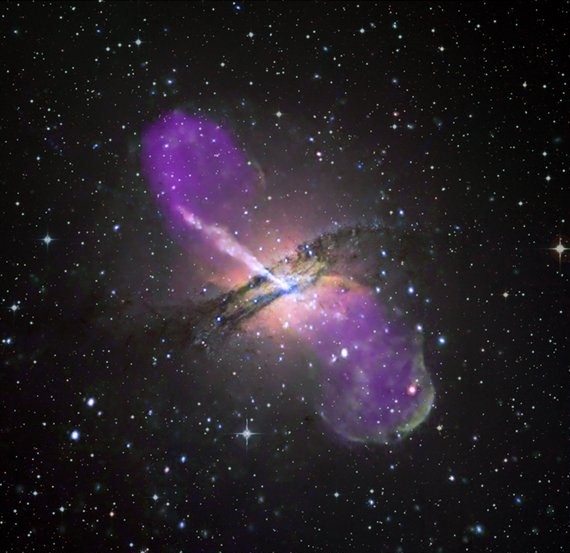Purdue astrophysicist charts a decade of discoveries on how black holes and neutron stars shine
2025-08-05

Centaurus A (example of a relativistic jet emerging from a galactic center). Photo Courtesy: ESA/NASA
Black holes and neutron stars are some of the most extreme objects in the universe. Though small compared to ordinary stars, they can occasionally emit more light than entire galaxies, and their brightness can change in an instant, sometimes in just thousandths of a second.
A new review article co-authored by Dimitrios Giannios, professor of Physics and Astronomy at Purdue University, examines a decade of breakthroughs that have reshaped scientists' understanding of how these compact cosmic powerhouses generate such enormous and variable energy.
The review, "Relativistic Magnetic Reconnection in Astrophysical Plasmas: A Powerful Mechanism of Nonthermal Emission," was co-authored with Lorenzo Sironi, professor at Columbia University, and Dmitri Uzdensky, professor at the University of Oxford. The article is featured on the ARAA (Annual Review of Astronomy and Astrophysics) website. It synthesizes advances in theory, simulation, and observation that point to magnetic reconnection, a process in which tangled magnetic field lines in a plasma break and realign, as a central mechanism behind the rapid flares and bursts of light emitted by black holes and neutron stars.
Magnetic reconnection is a familiar phenomenon to solar physicists. It drives solar flares, which are sudden releases of energy from the sun that can disrupt satellites and power grids on Earth. But near black holes and neutron stars, reconnection occurs under far more extreme conditions, where gravity bends space-time, plasma moves at nearly the speed of light, and magnetic fields are billions of times stronger than anything produced on Earth.
"Black holes and neutron stars behave like rapidly spinning, super-powerful magnets," Giannios said. "As gas falls toward them, it gets caught in intense magnetic fields, heats up to millions or even billions of degrees, and is sometimes ejected in beams of plasma moving close to the speed of light."

3D structure of the magnetic field in the jet. Photo Courtesy: Barniol Duran.
This makes these objects ideal "natural laboratories" for studying plasma physics at its limits, physics that can't be replicated in conventional Earth-based experiments.
The review charts how the field has evolved over the last 10 to 20 years. New computational tools have made it possible to simulate the behavior of highly magnetized plasma under extreme conditions, bridging a longstanding gap between theory and observation.
"In our review article, we summarize the latest theoretical advances that explain how magnetic reconnection works in these environments and how it accelerates particles to nearly the speed of light," Giannios said. “We also explore how cutting-edge computer simulations have helped us model these processes in detail, and how these insights are being tested against both astrophysical observations and laboratory experiments here on Earth.”
The article also highlights how these insights are being tested through observations of flares from black holes and neutron stars, as well as through laboratory experiments on high-energy plasmas that reproduce some of the physics happening near these objects.
“Understanding these violent yet beautiful cosmic events isn’t just about exotic physics—it helps us grasp how energy moves and transforms in the Universe,” Giannios said. “And with each discovery, we get closer to solving some of the deepest mysteries surrounding black holes, neutron stars, and the powerful light they emit.”
While the review covers complex physics, Giannios emphasized that it was also written to be accessible to students and early-career scientists. "The review is written in a pedagogical manner and, as such, will serve as an important text to train the next generation of scientists," he said.
Giannios noted that the research builds on contributions from graduate students and postdoctoral researchers in his Purdue group over the past decade, as well as collaborations with leading plasma physicists worldwide.
Purdue's Department of Physics and Astronomy has established a strong team studying extreme astrophysical plasmas. This research combines theory with high-performance computing facilities at Purdue University and utilizes national computing resources supported by NASA and the National Science Foundation.
The review article offers a roadmap for the next generation of research on relativistic magnetic reconnection, serving as both a reference for experts and an entry point for students entering the field.
The work was supported by multiple NASA and National Science Foundation grants. Giannios emphasized that this funding is "essential for basic research and for training the next generation of U.S. scientists."
About the Department of Physics and Astronomy at Purdue University
Purdue’s Department of Physics and Astronomy has a rich and long history dating back to 1904. Our faculty and students are exploring nature at all length scales, from the subatomic to the macroscopic and everything in between. With an excellent and diverse community of faculty, postdocs, and students who are pushing new scientific frontiers, we offer a dynamic learning environment, an inclusive research community, and an engaging network of scholars.
Physics and Astronomy is one of the seven departments within the Purdue University College of Science. World-class research is performed in astrophysics, atomic and molecular optics, accelerator mass spectrometry, biophysics, condensed matter physics, quantum information science, and particle and nuclear physics. Our state-of-the-art facilities are in the Physics Building, but our researchers also engage in interdisciplinary work at Discovery Park District at Purdue, particularly the Birck Nanotechnology Center and the Bindley Bioscience Center. We also participate in global research including at the Large Hadron Collider at CERN, many national laboratories (such as Argonne National Laboratory, Brookhaven National Laboratory, Fermilab, Oak Ridge National Laboratory, the Stanford Linear Accelerator, etc.), the James Webb Space Telescope, and several observatories around the world.
Written by: David Siple, Communications Specialist, Purdue University Department of Physics and Astronomy